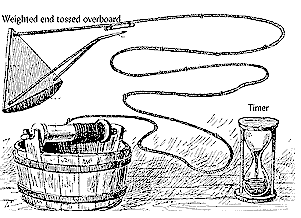A Sailor's Tale
My husband and I spent several summers sailing out of Woods Hole, Massachusetts. I'll never forget returning from Buzzards Bay one particular breezy afternoon.
The sun was shining and our sails were filled with wind. The knot meter showed us making steady progress into the channel at over five knots. However, we couldn't seem to make it past the buoy on our left.
I was puzzled. I looked at the coastline, and saw that the view wasn't changing. Apparently, we weren't actually moving forward. Somehow, the knot meter was wrong!
Tom stayed at the helm while I went down below to look at the LORAN (Long Range Aid to Navigation) readout. The strangest thing was happening.
According to the LORAN, our speed was dropping! I watched, horrified, as it dropped to zero.
Then, slowly, our speed started climbing again. However, our heading had changed by 180 degrees. Suddenly the truth dawned on me - we were going backwards! Our bow was pointed toward the channel, but we were being pushed farther and farther away by the tide. We were trying to sail against the tide. And we weren't making headway. We didn't have the power to overcome the tide.
Many business leaders have shared similar experiences with me. All of their performance measures show the business is moving forward. Yet, somehow, their pretty sure they're merely standing still, or even losing ground. How does this happen?

Well, in my case, our primary indicator was the knot meter. The whole concept of measuring a ship's speed using "knots" started centuries ago when sailors threw a line overboard, and observed how quickly the rope would unwind from a spool. The length of the line was measured by knots tied at equal distances. This method measured the speed of the boat with respect to the water.
Of course, our knot meter was electronic. And while I assumed the knot meter was measuring our speed, I was wrong. A tiny paddle wheel spun as water passed under the hull. And this spinning action was translated into knots per hour. Our knot meter, just like the ancient knotted spool and hour glass, measured the speed of boat with respect to the water. NOT the speed of the boat with respect to land.
Measurements in Business
What happens in business? Many times leaders focus on one or two key measures. For example, many business owners track revenue. Of course, there's nothing wrong with tracking revenue. However, it's helpful to have a perspective to know whether you are moving closer to your goals. Just like a seemingly fast boat being pushed off course by the tide, you may be gaining revenue while losing profitability.One of my clients had a common situation: two lines of business with one growing more rapidly. When she analyzed her costs by project, she discovered that one line of business was profitable, and one was not. The profits in one line were covering up the losses in another line.
Unfortunately, the faster growing business was the unprofitable one! The more work they did, the more money they lost. And, not surprisingly, the salespeople were getting commission pay based on revenue. So they kept selling more unprofitable business.
When she made the tough decision to close down the unprofitable line of business, her profitability immediately improved.
Back in Buzzards Bay
In case you're wondering, Tom and I were not dashed ashore in our sailboat. Unlike King Canute, we knew our limitations. Once we understood the situation, we turned on the motor, took down the sails, and powered back to our home port.


1 comment:
Good point. Sometimes the numbers don't tell you what's really going on. Maybe you need a different instrument. Or maybe you just need to look up from your dashboard.
Love your writing, Sheila!
Post a Comment